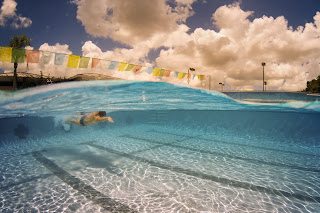(Thanks to Josh Scott and SwimRX for the pic!)
- The obvious- make sure your wetsuit is on correctly. Really make sure the arms are pulled well up into your armpit and over your shoulders. As well, pull it up way into your crotch so it’s not pulling “down on you”.
Leave plenty of time for this process so you aren’t struggling and frantic heading into the water. And finally if it feels too tight while swimming, tug in the neck like to let some water in. It will make it feel A LOT more roomy. You can even do that mid stroke - trust me, I have 🙂
Even in hot water races where they are barely legal, it’s a great way to not over heat.
- Find “cues” in swimming every day. The sounds or your exhale under water (I used to make a noise when i did mine and would listen for it). The sound of your “tempo” or whatever. Look for your hands as they start your catch, is another good one once in awhile.
Point is you can always seek out those “anchor points, and check in with your rhythm, even in murky water
- Practice wiggling your fingers and the front part of your stroke. If you can’t, you’re too tense. Being tense will raise your HR, and slow you down. Even in Kona, trying to make the front pack, I’d still every 7 or 8 strokes try to make sure I could do that. Be strong with your pull, but not tense
- Realize NOBODY wants. To touch you. If they do, they don’t mean it and will instantly try to not. So if it happens, not a big deal.
In cycling, when coaching my ITU athletes, they would do a drill in the grass at ale speed, trying to push each other out of the circle. They realized that if they held their arms tense, they would be pushed right out, but if they stayed relaxed and loose, they really could absorb a lot of force.
So play around with your friends a bit in the water. Push each other a bit, play tag, or keep away with a ball. Get used to contact, and i can’t tell you, if they are coming at you like that and you’re fine. You’ll be more than fine when people are trying to avoid you
- Obviously, stay off the fast lines. Swimming 10-15 yard off the side will DRAMATICALLY reduce contact. Is it a “slower line”? Not if you’re not panicking and in a good tempo
- Which is another point. StarT WAY easier than you think you should. Most likely you’re still starting too fast. So stay as relaxed as you can
One drill I used to have swimmers do, is show me how slow they can swim a length. I used to say, you can swim fast, until you can swim relaxed
- Learn breast stroke. Realize you can do that at any point of time and breathe as much as you need.
-Keep in mind the swim will be over soon, so do not try to “Pr”, just swim relaxed. I used to ask a lot of nervous swimmers, if you swam 5 min slow but the rest of your ironman went as planned, would REALLY be that upset? Most likely no.
But if you swim 5 min too fast, it can change your blood chemistry and how you burn fuels for hours.
Look at Ryf, I think she proved the swim can be over come:)
- Realize only one person can be on your left or right at any one time.
Finally I’ll say this.
Learning ANY drill is going to teach you awareness and proprioception in the water.
So that will be help you if knocked just know how to get yourself centered again
Learning ANY drill is going to teach you awareness and proprioception in the water.
So that will be help you if knocked just know how to get yourself centered again


